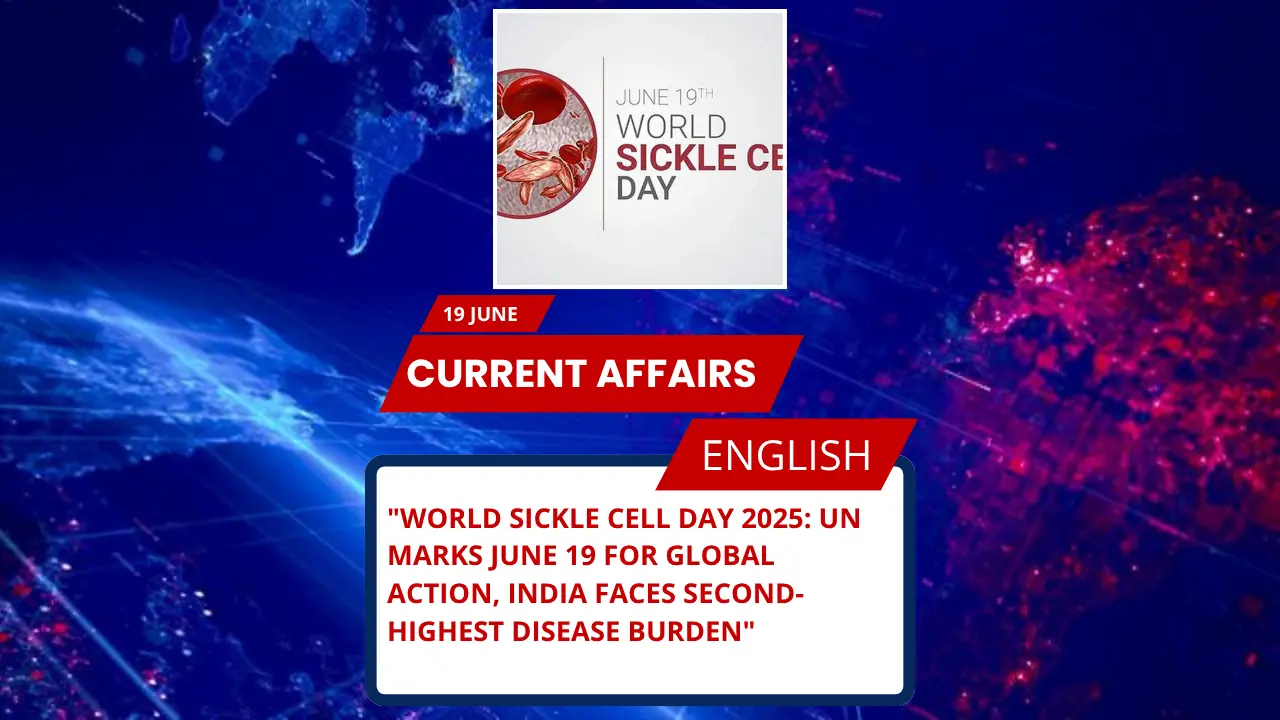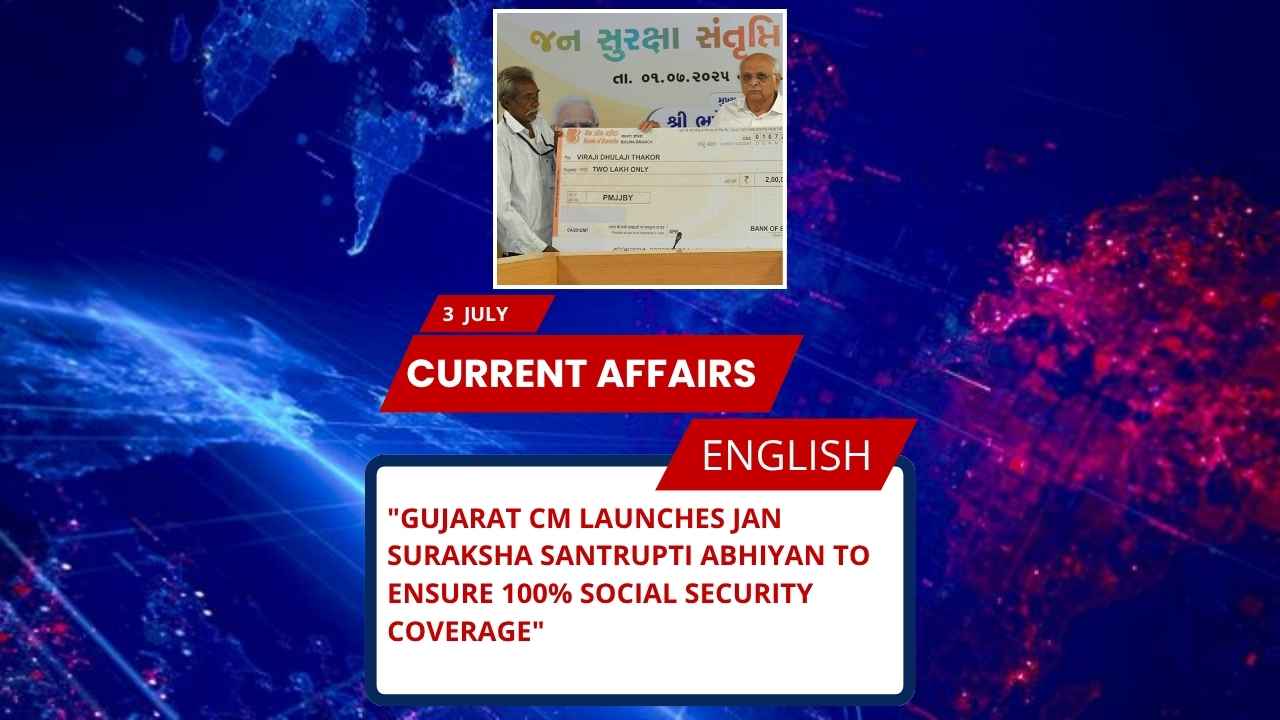
Key Points for SSC, UPSC & Other Govt Exams
- World Sickle Cell Day is observed annually on June 19.
- Declared by the United Nations in 2008.
- Theme for 2025: “Global Action, Local Impact: Empowering Communities for Effective Self-Advocacy”.
- India ranks second globally in sickle cell disease burden.
- Affects predominantly Scheduled Tribes and forest-dwelling communities.
- Sickle cell trait is inherited and not a disease, but a carrier status.
- Early diagnosis through blood tests (CBC, MCV, HPLC, etc.) is essential.
- Sickle cell gene evolved in Africa as a malaria defense mechanism.
World Sickle Cell Day 2025 – Theme, History, Importance & India’s Challenges
Why World Sickle Cell Day Is Observed on June 19
World Sickle Cell Day is a globally recognized awareness day, observed on June 19 every year. It was officially designated by the United Nations General Assembly on December 22, 2008, to raise awareness about the widespread impact of sickle cell disease—a hereditary blood disorder affecting over 300,000 newborns annually worldwide.
The primary goal is to educate the public on early detection, medical care, and community advocacy.
Theme of World Sickle Cell Day 2025
Theme: “Global Action, Local Impact: Empowering Communities for Effective Self-Advocacy”
This year’s theme encourages grassroots engagement while aligning with global initiatives. It urges local communities, especially in tribal and underserved regions, to advocate for better healthcare, early detection, and social support systems for sickle cell patients.
History of Sickle Cell Disease
Genetic Evolution and African Roots
The sickle cell gene is believed to have evolved in Africa, as a natural genetic adaptation to fight malaria. Even before modern medicine, tribal communities recognized symptoms and had traditional terms for this condition.
UN Recognition
In 2008, the UN passed a resolution acknowledging sickle cell disease as a global public health problem, especially prevalent in low- and middle-income countries. This recognition led to the annual observation of World Sickle Cell Day on June 19.
Sickle Cell Disease in India
India faces a massive burden, being home to the second-largest population affected by sickle cell disease. The condition is highly concentrated in marginalized communities, including Scheduled Tribes (STs) and forest-dwelling tribal populations.
Due to socioeconomic inequities, many patients remain undiagnosed or untreated, demanding equity-based action plans and community-level engagement.
Sickle Cell Trait – What You Must Know
Inheritance Pattern
- Inherited from parents carrying the gene.
- Trait ≠ Disease (Only one copy of the gene = trait, not full disease).
- Risk of disease increases when both partners carry the trait.
Inheritance Statistics:
- One parent carries the gene → 50% chance child is a carrier.
- Both parents carry the gene → 25% chance child will have sickle cell disease.
Blood Tests to Detect Sickle Cell Trait
H3: Recommended Tests
- Complete Blood Count (CBC): Checks for anemia.
- Mean Corpuscular Volume (MCV): Identifies abnormal hemoglobin.
- Hemoglobin Electrophoresis / HPLC / DNA Testing: Determines exact hemoglobin type.
Newborn Testing: Recommended within 24–48 hours of birth. If missed, testing in adulthood is crucial—especially for couples planning children.
Important Information About the United Nations
- Founded: 1945
- Headquarters: New York City, USA
- Secretary-General (2025): António Guterres
- Primary Objective: International peace, cooperation, and humanitarian goals
- Related Bodies: WHO, UNICEF, UNDP
MCQs for SSC, UPSC & Other Govt Exams
Q1. What is the theme of World Sickle Cell Day 2025?
A. Hope Through Progress
B. Global Action, Local Impact
C. Shine the Light on Sickle Cell
D. Building Global Communities
Answer: B
Q2. When was World Sickle Cell Day officially recognised by the UN?
A. 2010
B. 2005
C. 2008
D. 2015
Answer: C
Q3. Which Indian population is most affected by sickle cell disease?
A. Urban Youth
B. Tribal Communities
C. Office Workers
D. Farmers in North India
Answer: B
Q4. What is the full form of CBC in the context of blood tests?
A. Central Blood Cell
B. Complete Blood Count
C. Cellular Blood Check
D. Comprehensive Biochemical Count
Answer: B
Q5. Which organization declared sickle cell disease as a public health problem?
A. WHO
B. UN
C. BRICS
D. NATO
Answer: B
H1: UPSC-Oriented FAQs with Answer Writing Format
Q1. Why is sickle cell disease considered a public health challenge in India?
Answer:
Sickle cell disease (SCD) is a significant public health issue in India due to its high prevalence in tribal and socioeconomically marginalized populations. With India carrying the second-highest global burden, the disease often goes undiagnosed and untreated, exacerbating morbidity and mortality rates. Geographic isolation, limited healthcare access, and low literacy contribute to this challenge. Early screening, public awareness, and community-level interventions are critical to address this health inequity.
Q2. Discuss the role of the United Nations in declaring World Sickle Cell Day.
Answer:
The United Nations declared June 19 as World Sickle Cell Day through a resolution passed on 22 December 2008. Recognizing sickle cell disease as one of the world’s most prevalent genetic disorders, the UN aimed to promote global and national-level awareness. The initiative seeks to ensure early diagnosis, reduce stigma, and mobilize international cooperation for healthcare research and support systems.
Q3. How can genetic counseling help prevent the spread of sickle cell disease?
Answer:
Genetic counseling plays a vital role in preventing the transmission of sickle cell disease. By identifying carriers of the sickle cell trait through early testing (CBC, HPLC, etc.), couples can make informed reproductive choices. When both partners are carriers, the risk of having an affected child is 25%. Counseling helps individuals understand risks, explore options like prenatal diagnosis, and raise public consciousness, particularly in high-risk communities.
Q4. Explain how India’s tribal health policies can be modified to address sickle cell disease.
Answer:
To tackle the rising burden of sickle cell disease among tribal populations, India’s health policies must become equity-focused. This includes:
- Mandatory newborn screening in tribal areas.
- Strengthening primary healthcare infrastructure in remote regions.
- Providing free diagnostic and treatment services.
- Conducting community-level education programs in local languages.
- Incorporating tribal voices in health planning.
Integrating sickle cell management into national tribal health missions can bridge existing gaps.







